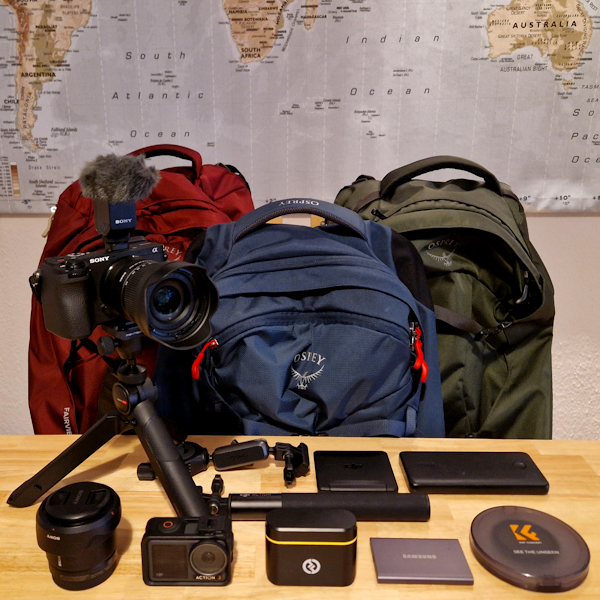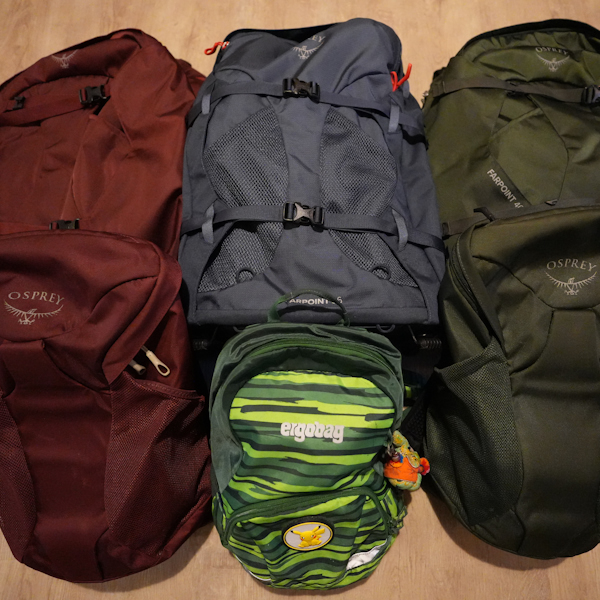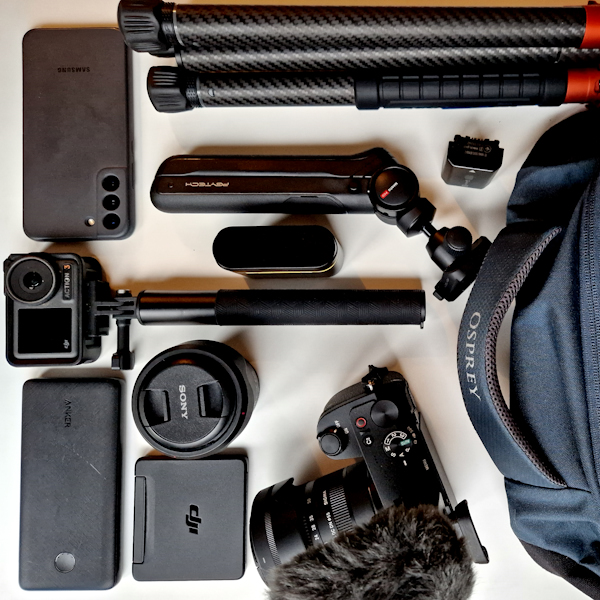
What we pack
Take a look what’s in our bags when we travel. We obviously need some additional tech equipment but we always try to travel as light-weight as possible and usually only with carry-on baggage when flying.
Our Backpacks
Main Backpacks: Osprey Farpoint 40, Fairview 40 and Farpoint 36 (wheeled)
This decision has been a tough one. After trying many different backpacks, we finally choose the bags from Osprey. They are very popular with backpackers – and it is for a reason. We travel with the 40 liter Farpoint (Thomas), the 40 liter Fairview (Claudia) and the 36 liter Farpoint (Norwin). The advantage of the 36 liter Farpoint is that it has wheels. This is important because one uf us carries the large backpack from our son, too.
They all comply with carry-on baggage when flying. The fit also the most low-cost carrier dimensions. That is a big plus because we like to save the cost for additional baggage check-in. The additional daypacks fit under the seats in front of us for longer flights.

Our Daypacks: Osprey Farpoint and Fairview (15 liter) and Ergobag Special Edition (10 liter)
We use the daypacks usually when discovering the destinations. We find it important that it is possible to put a water bottle on the outside to reach it quick. It has also be enough space for our camera gear and some other things. For that the Osprey daypacks are perfect. Our son has its own backpack he choosed. For us it was important that it is light. This one has only 370 g.

Our Filming Gear
Main Camera: Sony A6700
Since our Thailand episodes we use this camera. It is Sony’s best APS-C camera. It has a remarkable good video quality. In addition, for us it was very important that the camera has a good stabilization because we are constantly on the go and like to avoid gimbals, is compact that it can be easily fit in our daypacks, is very good in low-light situations and don’t break the bank like many other full-frame cameras. This one is the perfect choice for our journeys.
Besides the camera, for the video quality it is essential to have also good lenses. But for us it is very important to travel with little and as light-weight as possible.
Wide Lens: Sony 11mm / f 1.8
This ultrawide-angle lens is one of the best wide lenses for the APS-C system. We use it usually for our vlogging situations when we film ourselves or in low-light situations because of its 1.8 aperture. The only drawback is that is has no stabilization. But for us it is acceptable because our camera has active stabilization. And if it is to shaky we adjust it in post-production.
Zoom Lens: Sigma 18-50mm / f 2.8
We use this lense mostly on all other situations, except in low-light situations. It has beautiful colors and a fast and silent autofocus. With its 18-50mm it has a very versatile focal length and a constant aperture of 2.8 throughout the zoom. It is great that this is a little lens. Together with the wide lens it is an impressive tiny set up. But this lens has also no stabilization. Again, no big deal for us.
Additional Lens: Viltrox 27mm / f 1.2
We decided to buy this lens because especially in very low-light situations, we couldn’t film as well as we wanted – there you need a lens with a larger maximum aperture. The advantage of the APS-C system of a small and lightweight setup also has a disadvantage. And this shows up in low-light situations. In addition to the very sharp image you get with this lens, with the aperture of f 1.2 it also performs very well in low light (like a f 1.8 on a full-frame camera). On the flip-side it is a larger and heavier lens then the two others.
Action Camera: DJI Osmo Action 3
Action cameras are inferior when it comes to video quality but on very shaky situations, like boat rides or on motorbikes, we have to use it to get proper video footage. In these situations we use the DJI Osmo Action 3. It has a good quality and its main advantage is that it is very robust. We used the camera when we had an motorbike accident in Thailand. The chest strap holder has been broken but not the camera, which was attached.
On-Camera Microphone: Sony ECM-B10
It is not an option to use the build-in camera microphones on cameras. Therefore, it is necessary to have an separate microphone to get a good audio quality. Most microphones are huge (at least with a dead cat for wind protection) and not very descrete. This is tiny and it is powered directly from the camera’s hot shoe. That means no additional cable or batteries, like the microphones from Rode or Sennheiser, we also tested. This is a big advantage.
Lavalier Microphone: Hollyland Lark C1
When we are not near the camera or on a motorbike for example, we cannot use the on-camera microphone. In these situations we have to use a lavalier microphone. It has a very appealing sound. We still use this one because he bought it when we made videos with our smartphones only (before our Thailand series). Because it has an USB-C port it is not possible to connect it with the camera without an adapter. The next time we would probably consider to buy the tiny Hollyland Lark M2 or the DJI Mic 2.
Small Tripod: Mantispod 2.0
It is necassary to have a small tripod, especially for vlogging scenarios. In addition, it should be small and lightweight. The Mantispod has also an Arca-Swiss plate to put the camera on with one click and it is very flexible. It is also noticeably cheaper than the older Mantispod Pro.
Large Tripod: Fotopro X-Aircross 3 Lite
In some situations it is preferable to have a large tripod for filming. We found it very difficult to select a tripod, which is as small and lightweight as possible, and is also not very pricey. It seems that many YouTube vloggers have the Travel Tripod from Peak Design. But this is incredible expensive. We bought the X-Aircross 3 Lite for more than a third of the price of the Peak Design. And it is smaller and lighter, too. We love it.